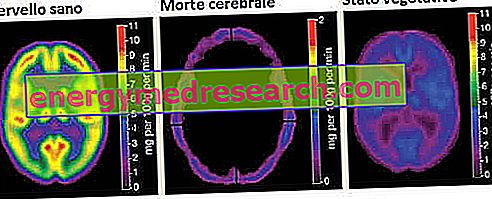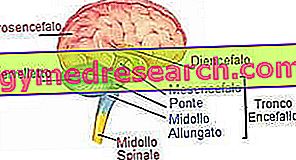Generality
There is talk of brain death when the brain, more precisely the brain stem, permanently interrupts its activity. This functional cessation is accompanied by several characteristic signs: above all, the absence of autonomous breathing and of any basic reflex; in fact, in the brain stem we find very important nerve centers that control breathing, pupillary reflexes and other vital reflexes.
The diagnosis of brain death must be made, for various reasons, by a team of medical specialists and involves several targeted tests.
A brain-dead patient can be connected to an artificial respirator to keep transplantable organs alive.
What is brain death
We speak of brain death when a person's brain, more precisely the brain stem, ceases to perform any activity. In this state, the loss of consciousness is final, as is the response to any external stimulus.
An individual, who is diagnosed with brain death, is considered dead, but can be connected to an artificial respiration machine.

THE ENCEPHALIC TRUNK
The brain stem is that region of the brain that connects the brain proper to the spinal cord. Because of the position it occupies, it can be considered as the base of the encephalon.
The trunk is divided into three parts: midbrain, bridge and medulla.

Figure: an overview of the brain areas . From the site: www.antoniosammartino.it
Starting point of almost all cranial nerves (except those associated with smell), the brain stem controls several vital functions, such as breathing, heart rate, swallowing and blood pressure.
In light of this, it can be guessed why damage to this portion of the brain could have such dramatic consequences as brain death.
Causes
Brain death occurs when the flow of blood to the brain is severely interrupted.
The interruption of blood supply. and its oxygen support, can occur mainly for the following reasons:
- Cardiac arrest . It is the situation in which the heart suddenly stops beating, thus depriving the brain and all other organs of the body of oxygen.
- Heart attack . It occurs when the flow of blood, which flows through the heart, suddenly stops. This causes damage to the myocardium, the heart muscle, and a reduction in cardiac activity.
- Stroke . It is characterized by the lack of blood supply to a more or less extensive region of the brain. The stroke can be of ischemic or hemorrhagic type; if it is ischemic, it means that at its origin there is an obstruction of the arterial vessels of the brain; if it is hemorrhagic, it means that it is caused by the rupture of a cerebral arterial vessel and the consequent loss of blood.
- Thrombosis and / or embolism . A blood clot, fixed (thrombus) or mobile (embolus), can clog blood vessels and interrupt blood flow in the direction of the brain.
MINOR CAUSES
Although it happens more rarely, it is possible that brain death occurs even after a severe head injury, an encephalitis infection, or a brain tumor .
Differences between brain death and vegetative state
Brain death and the vegetative state are two different pathological conditions. In the first case, in fact, the responses of the brain are completely non-existent, while in the vegetative state there is still a minimal brain activity. In fact, although he is not aware of it and does not react to the surrounding environment, an individual in a vegetative state is alert, has open eyes, a regular heartbeat, breathes independently and still has the typical reflexes of the brainstem (for example, reflexes). corneal and pharyngeal).
Main differences between brain death and vegetative state | |
In the vegetative state
| In brain death
|
TYPES OF VEGETATIVE STATE. THE CAUSES
Although the vegetative state always presents itself with the same characteristics, two forms can be distinguished: one persistent and one permanent .
A vegetative state is classified as persistent when it lasts for more than 4 weeks; it is instead defined as permanent when its duration goes from 6 to 12 months.
This distinction is only formal, since the (few) possibilities of recovery are the same.
The causes that cause the vegetative state are in some ways the same ones cited for brain death, namely: brain trauma, blockages of blood flow (and oxygen) to the brain, heart attacks and neurodegenerative diseases (Parkinson's, Alzheimer's, tumors, etc.). ).
Diagnosis
The diagnosis of brain death is decreed if the patient shows the following conditions:
- Absence of response to any external stimulus
- Unconsciousness
- Only and exclusively artificial respiration
- Signs of serious and irreparable brain damage
The tests, which verify the aforementioned conditions, must be carried out by at least two specialist doctors (in Italy, three) and repeated at least twice . Furthermore, another important aspect is the fact that medical consultation must affect people not involved in organ transplants; indeed, as we shall see later, this subject is particularly important.
MEDICAL ADVICE
The medical advice, intended as a medical meeting, in Italy, belongs to three specialists: a medical examiner, a neurologist and an anesthesiologist-resuscitator .
DIFFERENTIAL DIAGNOSIS
The differential diagnosis consists of all those investigations aimed at excluding one or more pathologies similar to the suspected one. Regarding brain death, three situations have been recognized with similar but reversible symptoms, or with the possibility of recovery of brain activity:
- Overdoses of drugs, tranquilizers, poisons or toxic chemicals
- Severe hypothermia, or body temperature below 28 ° C
- Advanced metabolic diseases, such as diabetes, or severe degenerative liver diseases, such as liver cirrhosis .
With a scrupulous medical advice, any doubt can be resolved.
TEST TO DECREE CEREBRAL DEATH
Repeating the set of the following tests at least twice is intended to minimize the possibility of making a mistake. Coming to the analyzes to be carried out, it is necessary:
- Illuminate the eye with a small torch, to see if pupillary reflexes are present. In case of brain death, there is no response.
- Stimulate the corneal reflex, touching the eye and observing if this closes. In case of brain death, there is no reaction.
- Compress the forehead and pinch the nose to stimulate a reaction. In case of brain death, there are no response movements.
- Insert ice water in the ear to stimulate possible ear movement. In the event of brain death, no movement occurs.
- Insert a thin plastic tube into the trachea, to cause a minimal pharyngeal reflex (coughing or retching). In case of brain death, the patient is unperturbed.
- Interrupt artificial respiration for short periods of time in order to see if there is a resumption of autonomous breathing. In case of brain death, the patient still does not breathe.
NB: it is possible that, during the execution of these tests, the individual under examination moves the limbs and / or the trunk.
These movements are not connected to the brain stem, consequently not even to brain death; they depend instead on the spinal cord, which could still be active.
DURATION OF OBSERVATION
In all, the observation of the patient under examination lasts: 6 hours, in the case of adults and children aged 5 and up; 12 hours, in the case of children from 1 to 5 years; 24 hours in the case of babies less than one year old.
DO YOU NEED ELECTROENCEPHALOGRAPHY?
Electroencephalography (EEG) is the instrumental examination that records the electrical activity of the brain. It is not strictly necessary to decree brain death.
Organ donation
At one time, when the equipment for artificial respiration was not yet in place, death was decreed when the patient's heart stopped beating.

Today, thanks to the development of breathing machines, it is possible to decree the death of a patient even if the heart of this is still beating.
What benefits can a heart still oxygenate the tissues of a dead individual?
THE DONATION
Keeping the body organs oxygenated, through artificial respiration, serves to keep them alive, in view of a possible transplant. Corneas, liver, kidneys and heart are just some of the most important organs to be explanted.
For the donation, you must have the consent of the relatives and make sure that there are no valid reasons for not putting it into practice.
As mentioned above, the finding of brain death in Italy is the responsibility of three doctors, without any interest in donations or transplants.
organ | Storage time (waiting to find a compatible patient on the waiting list) |
Cornea Liver Kidney Heart | 10 days 18 hours 72 hours 5 hours |



